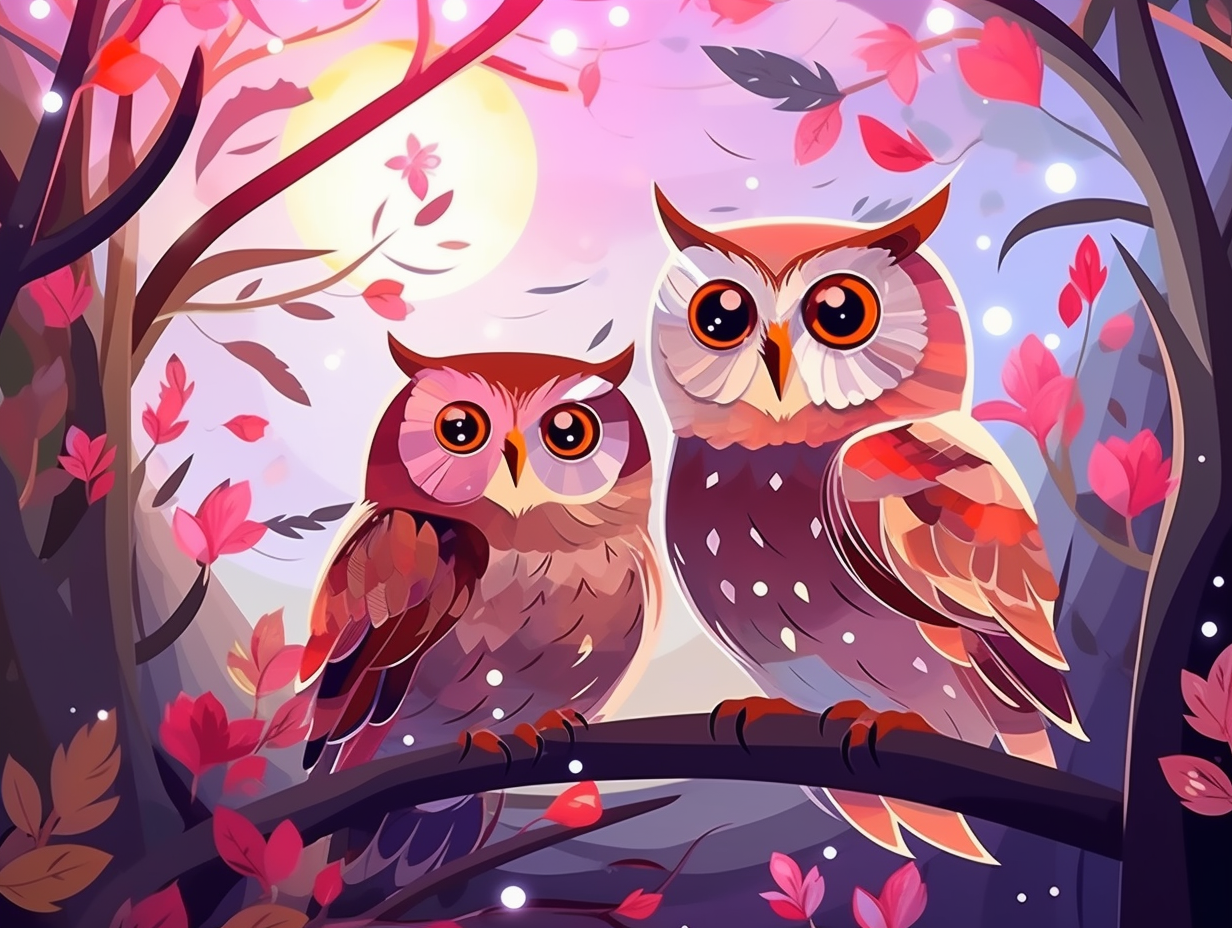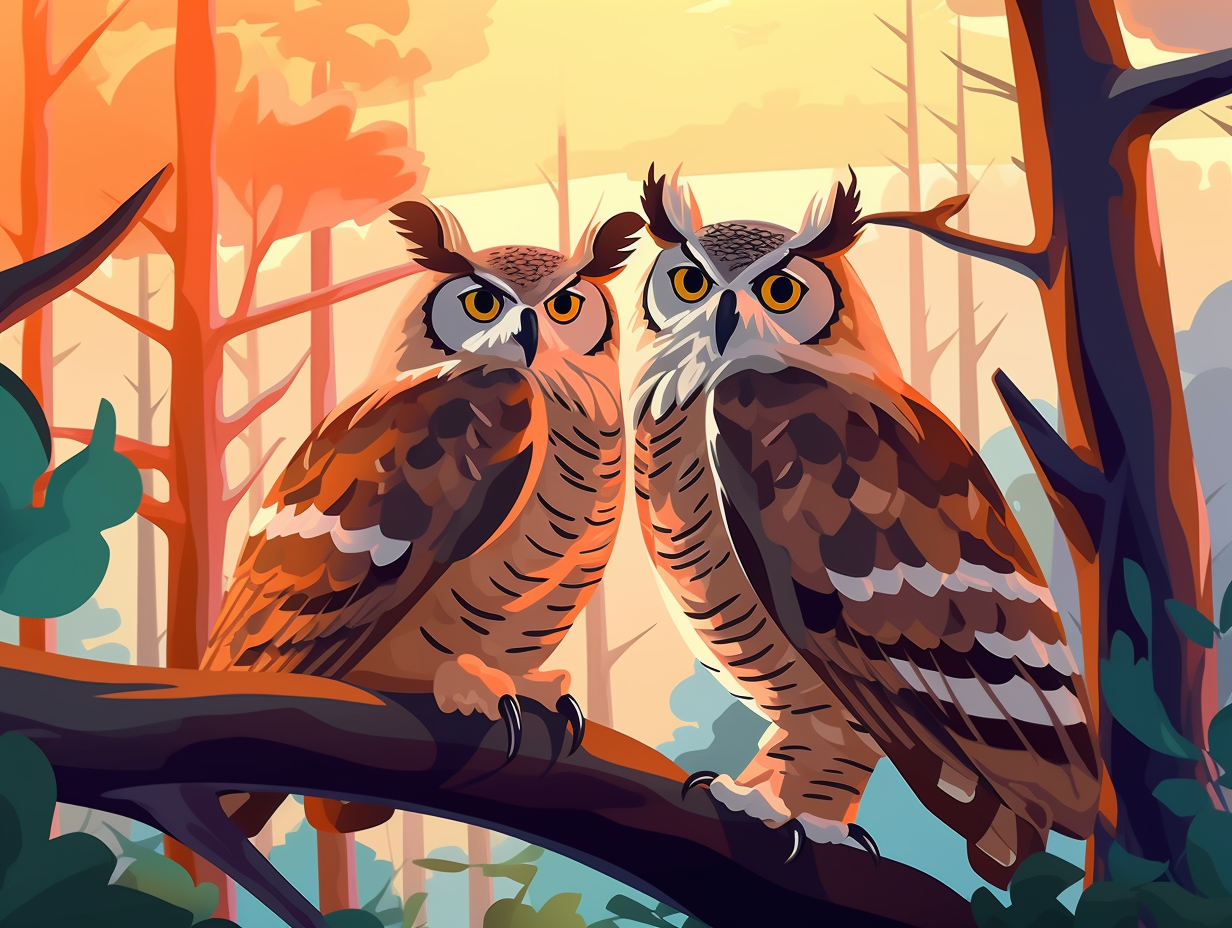Discover the Nocturnal World: Top 22 Fun and Fascinating Facts About Owls

1. Nature's Noise-Cancelling Headphones
Owls, nature's original noise-cancelling headphones: Their ruff feathers not only look fabulously chic, but also serve as an acoustic amplifier, channeling sound waves directly to their asymmetrically placed ears for pinpointing prey with incredible precision – even at frequencies so high, human ears would tingle!
Source => bto.org
2. Headspinning Gymnasts
Who needs rotating eyeballs when you're a gymnast with feathers? Owls have mastered the art of the headspin without breaking a sweat - or ruffling a single feather: These stealthy fluffballs can turn their heads 270 degrees without causing themselves any harm, allowing them to scope out their surroundings and hone in on their prey while maintaining absolute silence. Silent but deadly, indeed!
Source => nationalgeographic.com

Did you know that barn owls are the ninjas of the bird world, equipped with a built-in radar system for hunting prey in complete darkness? 🦉 Discover their incredible abilities and screeching calls that can be heard over a mile away!
=> Fun Facts about Barn-Owls
3. Zygodactyl Claws & Feathered Leg Warmers
If you've been wondering where to buy size-tiny owl sneakers, look no further - these specialized birds haven't the need for fancy footwear: Owls come equipped with zygodactyl claws for flawless prey-snatching action and feathered legs as built-in leg warmers, keeping them cozy even when the thermostat dips lower than a frozen penguin's beak.
Source => avibirds.com
4. Lightweight Elf Owl
Move over, golf balls - there's a new lightweight in town that has you beat in the world of tiny predators: The Elf Owl, with a talent for scorpion hoarding and beetle-hunting, has big yellow eyes and tips the scales at just under an ounce and a half.
Source => audubon.org

5. Eye-tastic Flexibility
"Who needs swiveling eyes when you have a neck that puts even the bendiest yoga instructor to shame?": Owls not only possess remarkable vision, but their tube-shaped eyes are fixed in their skulls, making their extraordinary neck flexibility - capable of turning their heads almost 360 degrees - an essential adaptation for a wide range of vision and successful hunting in dimly lit environments.
Source => mcgill.ca
6. Exceptional Day and Night Vision
Whoever said owls should invest in night-vision goggles never met these magnificent creatures: Owls actually have exceptional day and night vision, thanks to their large eyes and high number of rod cells, with some species even being diurnal or crepuscular.
Source => nrtofeaston.org
7. Spit Out Pellets
Whoever said "spit it out" clearly took inspiration from our wise feathered friends: owls are known to regurgitate indigestible parts of their prey in the form of pellets, which can be studied to gain insights about their diverse diet and hunting grounds.
Source => iowabirds.org
8. Silent Flight Agents
Who needs stealth mode when you can have owl mode: Owls silently swoop through the night like covert agents, thanks to specialized feathers on their wings and legs that minimize aerodynamic noise during flight, making them the James Bonds of the avian world.
Source => asknature.org
9. Daytime Party Owls
While other owls prefer "lights out" and a good old midnight snack hunt, the Northern Hawk Owl is that swinger, daytime partying owl you'll find chilling with the sunbathing crowd: Surprise, surprise, this feathery anomaly is diurnal, making the most of daylight hours for its breeding and feeding shenanigans, defying the stuffy norms of nocturnal brethren.
Source => worldbirdsanctuary.org

10. Oscar-worthy Ear Tufts
Whoever said the Great Horned Owl missed a career in theatre must be spot on: with ear tufts that play a dual role in portraying emotions and mastering the art of disguise, their plumes are truly an Oscar-worthy accessory. These magical feathers not only help our nocturnal friends look larger and angrier when they're confronting danger, but also let them morph into a master of camouflage, sneaking against tree trunks in stealth mode like an ancient ninja : The ear tufts of these magnificent birds serve useful purposes, acting as a means of expressing their emotions and transforming their appearance to blend in seamlessly with their environment, making them appear as mere bulges on trees.
Source => raptorrehab.org
11. Natural Sound System
Step aside, satellite dishes, the barn owl has a natural sound system that'd leave any DJ ruffling with envy: Equipped with a facial ruff that expertly directs sound to their ear openings, these nocturnal ninjas can pinpoint their prey in complete darkness, thanks to the reflector feathers that fine-tune frequencies and keep them one flap ahead.
Source => pubmed.ncbi.nlm.nih.gov
12. Binocular Vision Detectives
Who-who thought Sherlock Holmes could be an owl? Rigorously solving nature's mysteries, these feathered detectives have a secret weapon: exceptional binocular vision. With a binocular visual field of 70 degrees out of their total visual field of 110 degrees, owls perceive images in three dimensions – a feat attributed to their highly evolved Visual Wulst, which rivals the pulvinar nucleus in humans and primates. Yes, these nocturnal gumshoes see what others can't, outwitting their prey and boggling our minds in the process.
Source => depts.ttu.edu
13. Nictitating Membrane Stealth
Here's looking at you, Owl Capone: Owls possess a third eyelid known as the nictitating membrane, which acts as a stealthy windshield wiper to protect and moisten their eyes while still allowing them 360-degree, night-vision goggles on crime-fighting patrol.
Source => ocvn.osu.edu
14. Owl Courtship and Wooing Dance
Step aside, Romeo and Juliet; the Great Horned Owls know a thing or two about love in the air and fancy footwork! Their wooing dance is a blend of a Victorian ball and a modern-day rom-com – complete with hoot-a-thons, bobbing, and giggling: During mating season, male Great Horned Owls hoot continuously for six weeks, attracting females with their smooth moves, and then engage in a courtship display filled with nodding, bowing, and wing-spreading. They cap off their performance with high-pitched giggles, screams, and bill-snapping, followed by a brief but zealous copulation, all while hooting ecstatically.
Source => naturallycuriouswithmaryholland.wordpress.com

15. Baby Owlet Identification
Don't be fooled by their fuzzy fashion statements and au naturel ear muffs: owlets can be distinguished from mature adult owls by their soft, fluffy down, less-developed color, and limited dexterity, making the game of "Who's the baby now?" much less perplexing.
Source => owlsfact.com
16. Romantic Suspense Plot for Snowy Owls
Just when you thought your love life was complicated, consider the snowy owl's romantic suspense plot: to breed or not to breed, that is the question determined by dinner availability! In all seriousness: snowy owl breeding habits hinge on the presence of food, so in scarce times, these monogamous lovebirds may skip breeding altogether. When they do partake in parenthood, females lay a clutch of 3 to 11 eggs and both parents turn into fierce nest protectors, fending off intruders as bold as wolves.
Source => nationalgeographic.com
17. Feathery Powerhouse
If you thought your gym buddy could lift heavy weights, just wait until you meet this feathery powerhouse: the great horned owl can carry prey up to four times its own body weight, enabling it to easily hunt and feast on adult rabbits and hares.
Source => birdfact.com
18. Midnight Munchy Hunters
Whoever said the early bird gets the worm, clearly forgot about owls and their midnight munchies: These nocturnal ninjas boast highly specialized hunting abilities that allow them to locate and snatch up prey that ranges from petite rodents to fearless foxes and wily weasels. With over 134 known species, owls have stealthily swooped into habitats around the globe, proving that they really do give a hoot about adapting to diverse ecosystems.
Source => carolina.com
19. Night Vision & Sixth Sense
If natural night-vision goggles and built-in lie detectors had a baby, it would surely be jealous of owls: These large-eyed avian wonders have incredible night vision, allowing them to pinpoint prey from yards away, and their specialized feathers on feet and beaks give them a sort of sixth sense, making them formidable predators of small mammals, insects, reptiles, and snakes.
Source => trvst.world
20. Bat vs. Owl Skirmish
"Bat" luck for owls in the sky-high duel: Owls may have a hoot hunting rodents, but their feathery fangs struggle to wrap around elusive bats mid-flight, as the winged mammals leverage their echo-location skills to evade capture. Fear not, wise guys: these nocturnal birds know when to switch gears, zeroing in on their batty prey during roosting hours instead, so they don't miss a beat!
Source => owlchatter.com
21. Owl-burrower Architects
Who needs a realtor when you're an African Grass Owl with superior digging skills? These owl-burrowers are the architects of the animal kingdom: They expertly create a complex labyrinth of tunnels in tall grass, stretching for meters, with multiple chambers for nesting, daytime naps, and late-night hootenannies. Talk about a wise home investment!
Source => animalia.bio
22. Backward Sleeping Positions
Who needs a head when you can just turn it backwards? Owls be like, "Been there, done that, got the 270-degree swivel-neck": These enchanting night dwellers not only snooze upright while clinging to branches, but can even enjoy sweet slumber with their heads rotated backward. Bonus nesting trivia: some species, such as the snowy owl and short-eared owl, prefer to bunk down in ground-based or abandoned squirrel dwellings.
Source => birdfeederhub.com
Related Fun Facts




















